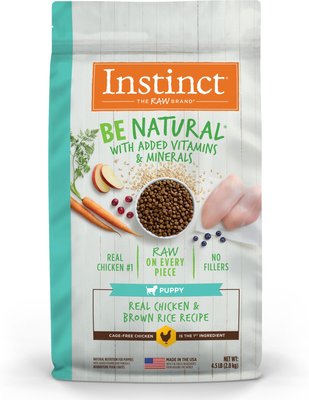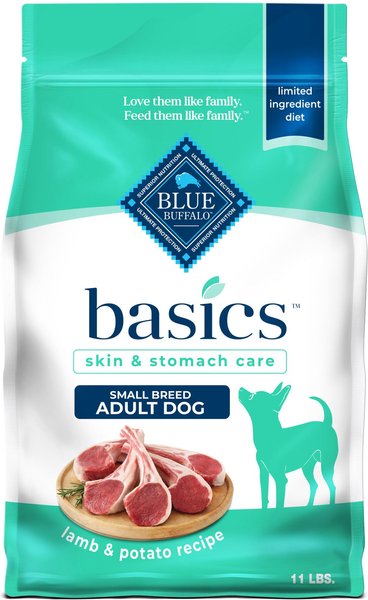What's the Best Dog Food for Pugs?

Jump to section
Breed Info
Breed Group:Toy | AKC Pug Profile
Ideal Weight:Female Adult: 14 to 18 pounds
Male Adult: 14 to 18 pounds
Exercise Need:20 to 40 minutes per day
Breed Summary
Pugs pack a lot of personality into small, muscular packages. They are excellent house dogs and get along with people of all ages. Pugs are happy being an only pet or as a member of a pack and they do well in both city and country settings. They do best in a moderate climate that’s not too hot or too cold, but they can thrive anywhere with the proper care.
Pugs come in three colors: silver or tan with a black face, or all black. They have short, glossy coats that require minimal maintenance, but they do shed. Pugs love to eat and snuggle, which means they are ideal companions but also makes them prone to obesity. Their short snouts can give them trouble breathing in very hot areas.
Physical Traits
Large round head, short snouts, wrinkly face, small but muscular body
Personality Traits
Loving, mischievous, friendly, eager to please
Health Considerations
-
Pugs have very short snouts and lots of wrinkles on their faces, which need to be cleaned on a regular basis to prevent infection or irritation. Their shortened snouts can also cause eye and vision issues, since there is less space for the eyeballs in the skull. That can lead to dirt and dust getting into the eye.
Pugs are unfortunately susceptible to serious conditions like pde and hip dysplasia, as well as more minor problems like eyelid and eyelash issues, skin infections, seizures, and allergies. Pugs are also prone to overheating, so be careful to keep your dog cool. -
Brachycephalic Airway Syndrome
Pugs's short snouts mean they have short and often flattened airways, which can cause difficulty with breathing and eating, and exercise intolerance as a result. Obesity makes these symptoms worse, so keep your dog at a healthy weight and avoid allergens that could further inflame the airway.
-
Joint Issues
Pugs can face joint issues like hip dysplasia, arthritis, and patellar luxation. Feeding them foods high in the following can help keep their joints healthy:
Recommendations:
Antioxidants・ Chondroitin・ Glucosamine・ Green Mussel・ Methylsulfonymethane・ Omega-3 from Fish Oil・ Taurine・ Turmeric・ Vitamin E -
Obesity
Pugs love to eat, so obesity can be a problem, especially with their small frames. A healthy diet and portion control along with regular exercise can keep them at a healthy weight. We recommend foods that are, or have:
Recommendations:
Large bites (to slow chewing)・ L-carnitine・ Low calorie・ Low fat -
Pug Dog Encephalitis (PDE)
PDE is an inherited disease in pugs, although it can occur in other small breeds. This disease is a serious autoimmune condition for which there is currently no cure, and it’s not known why some pugs develop the disease while others do not. Medication and a healthy diet may help.
Get a tailored nutrition profile for your dog
Our free nutritional assessment tool provides individualized recommendations based on your dog's breed characteristics, age, weight, body condition score, and activity level. It only takes 30 seconds to receive science-based insights to support your dog's lifelong health.
Are Fresh Food Diets Good for Pugs?
Only if they’re properly balanced.
Many well-intentioned Pugs parents spend a lot of time preparing meals at home, but health benefits are lost if meals aren’t properly portioned and balanced with all the nutrients dogs need. Recently, a few companies have done an excellent job ensuring accurate portions and nutrient balance by delivering pre-prepped fresh meals customized to the size and needs of your dog. Farmer’s Dog, Ollie and Nom Nom have each been approved by our nutrition team as delivering truly quality and well-balanced meals. They can be a little expensive (usually 3-4x more per day than kibble), but many find the added health benefits worth the cost. They do offer discounts to new customers, though, if you’d like to try one out.
Pros and Cons of Fresh Food Diets
✓ Diets balanced by Nutritionists・ ✓ Customized portions for weight control・ ✓ Superior digestive and immune health ・✕ More expensive than standard dog food
Foods We Recommend for Pugs Puppies
How long do Pugss need puppy food?
Until they're 10 to 12 months old.
Pugs are very focused on growing, and how we feed them should help them do just that. Since they have so much growing to do, they need higher amounts of nutrients than adult dogs, especially proteins, fats, carbohydrates, vitamins, minerals and — don’t forget — water. It’s still important to not overfeed puppies, so make sure to portion food and keep treats to no more than 10% of their caloric intake. Since balance is so important, we recommend that your young Pugs is eating food that is made just for puppies from a reputable brand.
Find the best nutritional start for your puppy
Our recommendation tool evaluates your puppy’s breed, age, growth stage, lifestyle, and health needs to identify a scientifically appropriate diet from over 10,000 options. Obtain personalized guidance to help support healthy development and lifelong wellness.
Foods We Recommend for Pugs Adults
When should Pugs start transitioning to adult food?
When they're 10 to 12 months old
From a nutrition standpoint, Pugs become adults once they reach about 90% of their expected weight. Once adults, our two key nutrition goals are balance and maintenance. We want balance because a dog’s body is responsible for a lot of things, like digestion, fighting infection, keeping muscles strong, and chasing squirrels. These are all important tasks, so we want to make sure each body function gets its share of nutrients. We also need to maintain a healthy weight. Underfed dogs are at risk for malnourishment, and overfed dogs can become obese — both of which lead to even worse problems for a Pug
Find the optimal nutrition plan for your adult dog
Our assessment analyzes your dog’s breed, age, lifestyle, and health considerations to recommend a scientifically selected diet from over 10,000 options. Personalized insights to help your dog thrive through adulthood.
Foods We Recommend for Pugs Seniors
When should Pugs start transitioning to senior food?
All dogs can age differently, but small dogs like Pugs can start to benefit from senior food around 8 to 10 years old
Ever watch kids running around the playground and wish you had that energy again? Yeah. Dogs get there, too. The metabolic processes in senior Pugs slow down as they age, which often means they aren’t needing quite as many calories as they did in their prime. Smart dog food companies have formulated senior diets to ease up on calories but still help them feel full and give them adequate maintenance protein. Still, like humans, everybody is different. Sometimes older dogs need just as many calories, or more, depending on how their bodies progress. So keep a close eye on their body condition, and look for dog foods made for seniors.
Support your senior dog's health with targeted nutrition
Our assessment analyzes your dog’s breed, age, and health considerations to recommend a science-based diet from over 10,000 options. Help maintain mobility, cognitive health, and quality of life.
Affiliate Disclosure:
We do not accept money to recommend pet foods. However, we do receive referral fees from online retailers (such as Chewy or Amazon) on qualifying purchases. Our recommendations are neutral, and diet recommendations are made without considering whether we will receive a referral fee.















